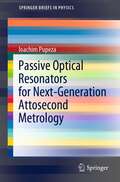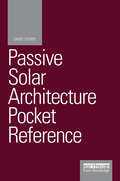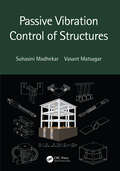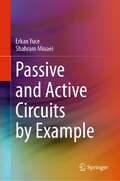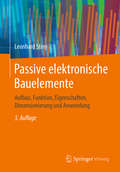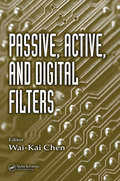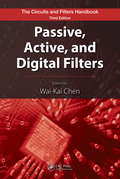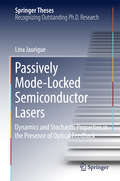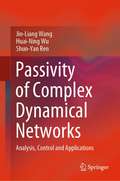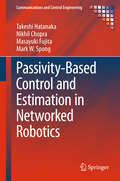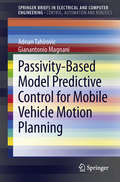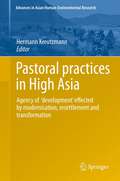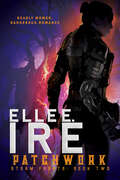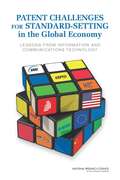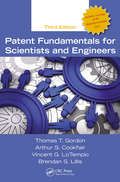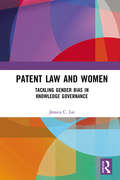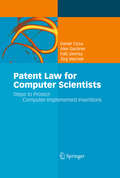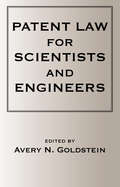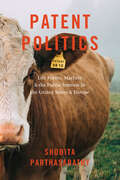- Table View
- List View
Passive Optical Resonators for Next-Generation Attosecond Metrology (SpringerBriefs in Physics)
by Ioachim PupezaThis book introduces readers to the development of a new generation of high pulse-repetition frequency instruments for multi-dimensional attosecond-resolution photoelectron spectroscopy (attosecond PES). It investigates the power scaling of femtosecond enhancement cavities for efficient intracavity high-harmonics generation (HHG). Further, it derives and verifies advanced resonator designs that feature large illuminated spots on all mirrors, which mitigate both intensity- and thermally-induced enhancement limitations.The dynamics of a high-finesse, passive resonator in the presence of a highly nonlinear optical process such as HHG are quantitatively investigated, both theoretically and experimentally. These investigations are instrumental in achieving the holistic optimization of the XUV source reported on here, which for the first time reached intracavity HHG conversion efficiencies comparable to those achieved in single-pass setups with a similar gas target.Coupling out the XUV beam from the enhancement cavity by purely geometric means, employing both the fundamental and higher-order transverse Gaussian modes, is studied. This offers the advantages of robustness, low distortion to the participating pulses, and photon-energy scalability. Last but not least, the author provides a range of proof-of-principle attosecond angle-resolved PES experiments.The book gives an outlook on the possible future development of cavity-enhanced HHG and an extensive discussion on the generation of isolated XUV attosecond pulses via intracavity wavefront rotation.
Passive Solar Architecture Pocket Reference: Second edition (Energy Pocket Reference)
by David ThorpeThis handy pocket reference contains a wealth of information on a range of topics including the principles of passive solar building and passive house, a ten-step design and build strategy, calculating solar irradiance, factors affecting the choice of building materials, passive heating and cooling principles and techniques in different climates, the Passivhaus Standard and natural and augmented lighting and notes on technology and building occupation. The book also includes conversion factors, standards, resources and is peppered throughout with helpful illustrations, equations, explanations, and links to further online resources. Ideal for practitioners, architects, designers, consultants, planners, home builders, students and academics, and those working in development contexts, the book is intended to act as an aide memoir, a reference supplement, a resource and an overview of the field. Rich in background detail, the book also includes at-a-glance tables and diagrams, equations and key definitions.
Passive Solar Energy in Buildings: Watt Committee: report number 17
by Patrick O´SullivanThis report indicates that the benefits that accrue to a building and its occupants from a consideration of solar radiation are greatest when the 'passive solar component' is seen in perspective, as a natural part of an integrated approach to climatically interactive low-energy building design.
Passive Treatments for Mine Drainage: A Guide for Early Researchers (SpringerBriefs in Applied Sciences and Technology)
by Andrew Holmes Cassandra Chidiac Aaron Bleasdale-Pollowy Frank GuThis book allows readers to grasp both the fundamentals and the latest technological advances in the field of mine drainage, which is increasingly crucial both environmentally and economically. Its extensive coverage of current and promising passive treatment technologies, combined with numerous practical guides, makes it an indispensable tool for early researchers seeking promising trends and identifying gaps.The book systematically explores recent literature on passive treatment research, classifying them as preventative, in-situ, and ex-situ solutions. It covers relevant passive treatments such as permeable reactive barriers, constructed wetlands, gravel bed reactors, saturated rock fills, and passivation techniques, among other common source control tactics. Each technology is discussed in terms of principal mechanisms, state-of-the-art technological advances, advantages and disadvantages, and suitability for a given mine drainage chemistry and flow regime. The book provides a comprehensive view of the entire field, offering researchers and policymakers a reference guide, research ideas, understanding, and practical applications for each technology.Furthermore, the contains an overview of recent trends in material selection for passive treatment applications, primarily through the use of industrial waste and by-products, which incorporate more sustainable practices in mine drainage remediation. Uniquely, the manuscript includes a flowchart based on water chemistry and flow rates to guide readers to ideal treatment options, along with written analysis to further support the readers’ decision-making. Overall, this equips early researchers in the field with knowledge of fundamentals and promising research routes when dealing with different mine drainage complexities while also providing them with promising research avenues that can advance the field further.
Passive Vibration Control of Structures
by Suhasini Madhekar Vasant MatsagarResearch in vibration response control deals not only with prevention of catastrophic failures of structures during natural or accidental/manmade hazards but also ensures the comfort of occupants through serviceability. Therefore, the focus of this book is on the theory of dynamic response control of structures by using different kinds of passive vibration control devices. The strategies used for controlling displacement, velocity, and acceleration response of structures such as buildings, bridges, and liquid storage tanks under the action of dynamic loads emanating from earthquake, wind, wave, and so forth are detailed. The book: Explains fundamentals of vibration response control devices and their practical applications in response mitigation of structures exposed to earthquake, wind, and wave loading Offers a comprehensive overview of each passive damper, its functioning, and mathematical modeling in a dynamical system Covers practical aspects of employing the passive control devices to some of the benchmark problems that are developed from existing buildings and bridges in different countries worldwide Includes MATLAB® codes for determining the dynamic response of single degree of freedom (SDOF) and multi-degree of freedom (MDOF) systems along with computational models of the passive control devices This book is aimed at senior undergraduate students, graduate students, and researchers in civil, earthquake, aerospace, automotive, mechanical engineering, engineering dynamics, and vibration control, including structural engineers, architects, designers, manufacturers, and other professionals.
Passive and Active Circuits by Example
by Shahram Minaei Erkan YuceThis book enables readers to become familiar with passive and active realizations of the impedances and important filter transfer functions (TFs). Firstly, time, s, and frequency domain analysis of the R-L, R-C, and R-L-C circuits are discussed. Then, active realizations of the impedances and TFs using different active devices are introduced. Readers will benefit from an example-driven approach to topics such as operational amplifiers, current followers, voltage followers, unity gain inverting amplifiers, negative impedance converters, first-generation current conveyors, second-generation current conveyors, third-generation current conveyors, differential voltage current conveyors, etc. will be introduced, which will be accompanied with a number of examples. Non-ideal gain effects on the performance of the active circuits are also demonstrated.
Passive elektronische Bauelemente: Aufbau, Funktion, Eigenschaften, Dimensionierung und Anwendung
by Leonhard StinyDieses Buch richtet sich an alle, die ein umfassendes Wissen über Herstellung, Aufbau, Eigenschaften, Funktionsweise und Einsatz passiver elektronischer Bauelemente benötigen. Bei deren Anwendung sind viele technische Daten zu beachten, welche dieses Buch zusammen mit Berechnungsgrundlagen zur Verfügung stellt. Theoretische und physikalische Grundlagen ergeben die Basis für Aufbauformen und Herstellungsverfahren. Die Eigenschaften von Bauelementen werden durch die angegebenen Größen und Charakteristiken verständlich, ihre Verwendung verdeutlichen Einsatzbeispiele, auch unter Betrachtung hochfrequenztechnischer Merkmale. Das Werk kann in der Lehre, im Studium sowie als Nachschlagewerk in der Praxis verwendet werden.
Passive, Active, and Digital Filters
by Wai-Kai ChenCulled from the pages of CRC's highly successful, best-selling The Circuits and Filters Handbook, Second Edition, Passive, Active, and Digital Filters presents a sharply focused, comprehensive review of the fundamental theory behind professional applications of these complex filters. It supplies a concise, convenient reference to the key concepts, models, and equations necessary to analyze, design, and predict the behavior of large-scale systems that employ various types of filters, illustrated by frequent examples. Edited by a distinguished authority, this book emphasizes the theoretical concepts underlying the processes, behavior, and operation of these filters. More than 470 figures and tables illustrate the concepts, and where necessary, the theories, principles, and mathematics of some subjects are reviewed. Expert contributors discuss general characteristics of filters, frequency transformations, sensitivity and selectivity, low-gain active filters, higher-order filters, continuous-time integrated filters, FIR and IIR filters, and VLSI implementation of digital filters, among many other topics.Passive, Active, and Digital Filters builds a strong theoretical foundation for the design and analysis of a variety of filters, from passive to active to digital, while serving as a handy reference for experienced engineers, making it a must-have for both beginners and seasoned experts.
Passive, Active, and Digital Filters (The Circuits and Filters Handbook, 3rd Edition)
by Wai-Kai ChenUpon its initial publication, The Circuits and Filters Handbook broke new ground. It quickly became the resource for comprehensive coverage of issues and practical information that can be put to immediate use. Not content to rest on his laurels, in addition to updating the second edition, editor Wai-Kai Chen divided it into tightly-focused texts that made the information easily accessible and digestible. These texts have been revised, updated, and expanded so that they continue to provide solid coverage of standard practices and enlightened perspectives on new and emerging techniques.Passive, Active, and Digital Filters provides an introduction to the characteristics of analog filters and a review of the design process and the tasks that need to be undertaken to translate a set of filter specifications into a working prototype. Highlights include discussions of the passive cascade synthesis and the synthesis of LCM and RC one-port networks; a summary of two-port synthesis by ladder development; a comparison of the cascade approach, the multiple-loop feedback topology, and ladder simulations; an examination of four types of finite wordlength effects; and coverage of methods for designing two-dimensional finite-extent impulse response (FIR) discrete-time filters. The book includes coverage of the basic building blocks involved in low- and high-order filters, limitations and practical design considerations, and a brief discussion of low-voltage circuit design.Revised Chapters: Sensitivity and Selectivity Switched-Capacitor Filters FIR Filters IIR Filters VLSI Implementation of Digital Filters Two-Dimensional FIR Filters Additional Chapters: 1-D Multirate Filter Banks Directional Filter Banks Nonlinear Filtering Using Statistical Signal Models Nonlinear Filtering for Image Denoising Video Demosaicking Filters This volume will undoubtedly take its place as the engineer's first choice in looking for solutions to problems encountered when designing filters.
Passively Mode-Locked Semiconductor Lasers
by Lina JaurigueThis thesis investigates the dynamics of passively mode-locked semiconductor lasers, with a focus on the influence of optical feedback on the noise characteristics. The results presented here are important for improving the performance of passively mode-locked semiconductor lasers and, at the same time, are relevant for understanding delay-systems in general. The semi-analytic results developed are applicable to a broad range of oscillatory systems with time-delayed feedback, making the thesis of relevance to various scientific communities. Passively mode-locked lasers can produce pulse trains and have applications in the contexts of optical clocking, microscopy and optical data communication, among others. Using a system of delay differential equations to model these devices, a combination of numerical and semi-analytic methods is developed and used to characterize this system.
Passivity of Complex Dynamical Networks: Analysis, Control and Applications
by Jin-Liang Wang Huai-Ning Wu Shun-Yan RenThis book intends to introduce some recent results on passivity of complex dynamical networks with single weight and multiple weights. The book collects novel research ideas and some definitions in complex dynamical networks, such as passivity, output strict passivity, input strict passivity, finite-time passivity, and multiple weights. Furthermore, the research results previously published in many flagship journals are methodically edited and presented in a unified form. The book is likely to be of interest to university researchers and graduate students in Engineering and Mathematics who wish to study the passivity of complex dynamical networks.
Passivity-Based Control and Estimation in Networked Robotics
by Masayuki Fujita Takeshi Hatanaka Nikhil Chopra Mark W. SpongHighlighting the control of networked robotic systems, this book synthesizes a unified passivity-based approach to an emerging cross-disciplinary subject. Thanks to this unified approach, readers can access various state-of-the-art research fields by studying only the background foundations associated with passivity. In addition to the theoretical results and techniques, the authors provide experimental case studies on testbeds of robotic systems including networked haptic devices, visual robotic systems, robotic network systems and visual sensor network systems. The text begins with an introduction to passivity and passivity-based control together with the other foundations needed in this book. The main body of the book consists of three parts. The first examines how passivity can be utilized for bilateral teleoperation and demonstrates the inherent robustness of the passivity-based controller against communication delays. The second part emphasizes passivity's usefulness for visual feedback control and estimation. Convergence is rigorously proved even when other passive components are interconnected. The passivity approach is also differentiated from other methodologies. The third part presents the unified passivity-based control-design methodology for multi-agent systems. This scheme is shown to be either immediately applicable or easily extendable to the solution of various motion coordination problems including 3-D attitude/pose synchronization, flocking control and cooperative motion estimation. Academic researchers and practitioners working in systems and control and/or robotics will appreciate the potential of the elegant and novel approach to the control of networked robots presented here. The limited background required and the case-study work described also make the text appropriate for and, it is hoped, inspiring to students.
Passivity-Based Model Predictive Control for Mobile Vehicle Motion Planning
by Adnan Tahirovic Gianantonio MagnaniPassivity-based Model Predictive Control for Mobile Vehicle Navigation represents a complete theoretical approach to the adoption of passivity-based model predictive control (MPC) for autonomous vehicle navigation in both indoor and outdoor environments. The brief also introduces analysis of the worst-case scenario that might occur during the task execution. Some of the questions answered in the text include: * how to use an MPC optimization framework for the mobile vehicle navigation approach; * how to guarantee safe task completion even in complex environments including obstacle avoidance and sideslip and rollover avoidance; and * what to expect in the worst-case scenario in which the roughness of the terrain leads the algorithm to generate the longest possible path to the goal. The passivity-based MPC approach provides a framework in which a wide range of complex vehicles can be accommodated to obtain a safer and more realizable tool during the path-planning stage. During task execution, the optimization step is continuously repeated to take into account new local sensor measurements. These ongoing changes make the path generated rather robust in comparison with techniques that fix the entire path prior to task execution. In addition to researchers working in MPC, engineers interested in vehicle path planning for a number of purposes: rescued mission in hazardous environments; humanitarian demining; agriculture; and even planetary exploration, will find this SpringerBrief to be instructive and helpful.
Past, Present and Future of Computing Education Research: A Global Perspective
by Mikko Apiola Sonsoles López-Pernas Mohammed SaqrThis book presents a collection of meta-studies, reviews, and scientometric analyses that together reveal a fresh picture about the past, present, and future of computing education research (CER) as a field of science. The book begins with three chapters that discuss and summarise meta-research about the foundations of CER, its disciplinary identity, and use of research methodologies and theories. Based on this, the book proceeds with several scientometric analyses, which explore authors and their collaboration networks, dissemination practices, international collaboration, and shifts in research focus over the years. Analyses of dissemination are deepened in two chapters that focus on some of the most influential publication venues of CER. The book also contains a series of country-, or region-level analyses, including chapters that focus on the evolution of CER in the Baltic Region, Finland, Australasia, Israel, and in the UK & Ireland. Two chapters present case studies of influential CER initiatives in Sweden and Namibia. This book also includes chapters that focus on CER conducted at school level, and cover crucially important issues such as technology ethics, algorithmic bias, and their implications for CER.In all, this book contributes to building an understanding of the past, present and future of CER. This book also contributes new practical guidelines, highlights topical areas of research, shows who to connect with, where to publish, and gives ideas of innovative research niches. The book takes a unique methodological approach by presenting a combination of meta-studies, scientometric analyses of publication metadata, and large-scale studies about the evolution of CER in different geographical regions. This book is intended for educational practitioners, researchers, students, and anyone interested in CER. This book was written in collaboration with some of the leading experts of the field.
Pasteur and Modern Science
by Rene DubosThis is a fresh account of the extraordinary life of Louis Pasteur, and the monumental impact he had on biochemistry, microbiology, bacteriology and immunology.
Pastoral practices in High Asia
by Hermann KreutzmannIn conventional views, pastoralism was classified as a stage of civilization that needed to be abolished and transcended in order to reach a higher level of development. In this context, global approaches to modernize a rural society have been ubiquitous phenomena independent of ideological contexts. The 20th century experienced a variety of concepts to settle mobile groups and to transfer their lifestyles to modern perceptions. Permanent settlements are the vivid expression of an ideology-driven approach. Modernization theory captured all walks of life and tried to optimize breeding techniques, pasture utilization, transport and processing concepts. New insights into other aspects of pastoralism such as its role as an adaptive strategy to use marginal resources in remote locations with difficult access could only be understood as a critique of capitalist and communist concepts of modernization. In recent years a renaissance of modernization theory-led development activities can be observed. Higher inputs from external funding, fencing of pastures and settlement of pastoralists in new townships are the vivid expression of 'modern' pastoralism in urban contexts. The new modernization programme incorporates resettlement and transformation of lifestyles as to be justified by environmental pressure in order to reduce degradation in the age of climate change.
Patchwork (Storm Fronts #2)
by Elle E. IreStorm Fronts: Book TwoEmpath Kelly LaSalle means everything to cybernetic soldier Vick Corren—and Kelly deserves a partner who can love her in a romantic way. For the first time since receiving her robotic enhancements and an AI that makes her faster and stronger than the average merc, Vick thinks she can be that person. Vick wants Kelly for life, and she’ll do whatever it takes to be worthy. A holiday on a tropical planet seems the perfect time for Vick to demonstrate her commitment. And she has big plans. But the best intentions unravel when they’re pursued by a rival mercenary company that wants Vick’s technology—with or without her cooperation. A competitor for Kelly’s affection is determined to tear them apart, and a lover from Vick’s past has depraved plans of her own. Vick might not be able to save their lives without giving herself over to the machine she’s trying so hard to transcend.
Patent Challenges for Standard-Setting in the Global Economy
by Keith MaskusPatent Challenges for Standard-Setting in the Global Economy: Lessons from Information and Communication Technology examines how leading national and multinational standard-setting organizations (SSOs) address patent disclosures, licensing terms, transfers of patent ownership, and other issues that arise in connection with developing technical standards for consumer and other microelectronic products, associated software and components, and communications networks including the Internet. Attempting to balance the interests of patent holders, other participants in standard-setting, standards implementers, and consumers, the report calls on SSOs to develop more explicit policies to avoid patent holdup and royalty-stacking, ensure that licensing commitments carry over to new owners of the patents incorporated in standards, and limit injunctions for infringement of patents with those licensing commitments. The report recommends government measures to increase the transparency of patent ownership and use of standards information to improve patent quality and to reduce conflicts of laws across countries.
Patent Fundamentals for Scientists and Engineers
by Thomas T. Gordon Arthur S. Cookfair Vincent G. LoTempio Brendan S. LillisThe most significant overhaul of the U.S. patent laws in decades occurred with the recent passage of the Leahy-Smith America Invents Act (AIA). Understanding the law that dictates what a patent is and how a patent is obtained and enforced, and the recent changes through statute or case law litigation presents unique challenges. This third edition o
Patent Law and Women: Tackling Gender Bias in Knowledge Governance
by Jessica C. LaiThis book analyses the gendered nature of patent law and the knowledge governance system it supports. The vast majority of patented inventions are attributed to male inventors. While this has resulted in arguments that there are not enough women working in science, technology, engineering and mathematics, this book maintains that the issue lies with the very nature of patent law and how it governs knowledge. The reason why fewer women patent than men is that patent law and the knowledge governance system it supports are gendered. This book deconstructs patent law to reveal the multiple gendered binaries it embodies, and how these in turn reflect gendered understandings of what constitutes science and an invention, and a scientist and an inventor. Revealing the inherent biases of the patent system, as well as its reliance on an idea of the public domain, the book argues that an egalitarian knowledge governance system must go beyond socialised binaries to better govern knowledge creation, dissemination and maintenance. This book will appeal to scholars and policymakers in the field of patent law, as well as those in law and other disciplines with interests in law, gender and technology.
Patent Law for Computer Scientists
by Jörg Machek Daniel Closa Alex Gardiner Falk GiemsaPatent laws are different in many countries, and inventors are sometimes at a loss to understand which basic requirements should be satisfied if an invention is to be granted a patent. This is particularly true for inventions implemented on a computer. While roughly a third of all applications (and granted patents) relate, in one way or another, to a computer, applications where the innovation mainly resides in software or in a business method are treated differently by the major patent offices in the US (USPTO), Japan (JPO), and Europe (EPO). The authors start with a thorough introduction into patent laws and practices, as well as in related intellectual property rights, which also explains the procedures at the USPTO, JPO and EPO and, in particular, the peculiarities in the treatment of applications centering on software or computers. Based on this theoretical description, next they present in a very structured way a huge set of case studies from different areas like business methods, databases, graphical user interfaces, digital rights management, and many more. Each set starts with a rather short description and claim of the "invention", then explains the arguments a legal examiner will probably have, and eventually refines the description step by step, until all the reservations are resolved. All of these case studies are based on real-world examples, and will thus give an inexperienced developer an idea about the required level of detail and description he will have to provide. Together, Closa, Gardiner, Giemsa and Machek have more than 70 years experience in the patent business. With their academic background in physics, electronic engineering, and computer science, they know about both the legal and the subject-based subtleties of computer-based inventions. With this book, they provide a guide to a patent examiner's way of thinking in a clear and systematic manner, helping to prepare the first steps towards a successful patent application.
Patent Laws for Scientists and Engineers
by Avery N. GoldsteinAlthough many texts attempt to explain intellectual property law to scientists and engineers, they are ineffective because they fail to present the subject within the proper scope; they are either too expansive or too detailed for the needs of researchers and inventors. Instead of giving a mile-high view of all types of intellectual property or, at
Patent Markets in the Global Knowledge Economy
by Thierry Madiès Thierry Madiès Dominique Guellec Jean-Claude Prager Dominique GuellecThe development of patent markets should allow for better circulation of knowledge and more efficient allocation of technologies at a global level. However, the beneficial role of patents has recently come under scrutiny by those favouring 'open' innovation, and important questions have been asked, namely: How can we estimate the value of patents? How do we ensure matching between supply and demand for such specific goods? Can these markets be competitive? Can we create a financial market for intellectual property rights? In this edited book, a team of authors addresses these key questions to bring readers up to date with current debates about the role of patents in a global economy. They draw on recent developments in economic analysis but also ground the discussion with the basics of patent and knowledge economics. Striking a balance between institutional analysis, theory and empirical evidence, the book will appeal to a broad readership of academics, students and practitioners.
Patent Politics: Life Forms, Markets, and the Public Interest in the United States and Europe
by Shobita ParthasarathyOver the past thirty years, the world’s patent systems have experienced pressure from civil society like never before. From farmers to patient advocates, new voices are arguing that patents impact public health, economic inequality, morality—and democracy. These challenges, to domains that we usually consider technical and legal, may seem surprising. But in Patent Politics, Shobita Parthasarathy argues that patent systems have always been deeply political and social. To demonstrate this, Parthasarathy takes readers through a particularly fierce and prolonged set of controversies over patents on life forms linked to important advances in biology and agriculture and potentially life-saving medicines. Comparing battles over patents on animals, human embryonic stem cells, human genes, and plants in the United States and Europe, she shows how political culture, ideology, and history shape patent system politics. Clashes over whose voices and which values matter in the patent system, as well as what counts as knowledge and whose expertise is important, look quite different in these two places. And through these debates, the United States and Europe are developing very different approaches to patent and innovation governance. Not just the first comprehensive look at the controversies swirling around biotechnology patents, Patent Politics is also the first in-depth analysis of the political underpinnings and implications of modern patent systems, and provides a timely analysis of how we can reform these systems around the world to maximize the public interest.
Patente in der Praxis: Einführung für Ingenieure und Naturwissenschaftler beim ersten Umgang mit technischen Schutzrechten
by Stefan BaslerDas Buch gibt einen Einblick in die Gewerblichen Schutzrechte, im speziellen, Patente und Gebrauchsmuster. Es ist in drei Hauptkapitel eingeteilt. Das erste Kapitel gibt eine kompakte Einführung in das Patentwesen und führt wesentliche Begriffe ein. Das zweite Kapitel erläutert die Elemente einer Patentschrift. Der Leser lernt in kurzer Zeit, eine Schrift zielgerichtet zu lesen und für sich zu bewerten. Das dritte Kapitel nimmt sich verschiedener Themen an, die für Personen von Interesse sein werden, die in ihrer Fachabteilung weiterführende Aufgaben im Patentwesen innehaben oder übernehmen möchten. Ausführliche Literaturlisten geben Hinweise für weiterführende Literatur der Patentämter und allgemeiner Natur.
